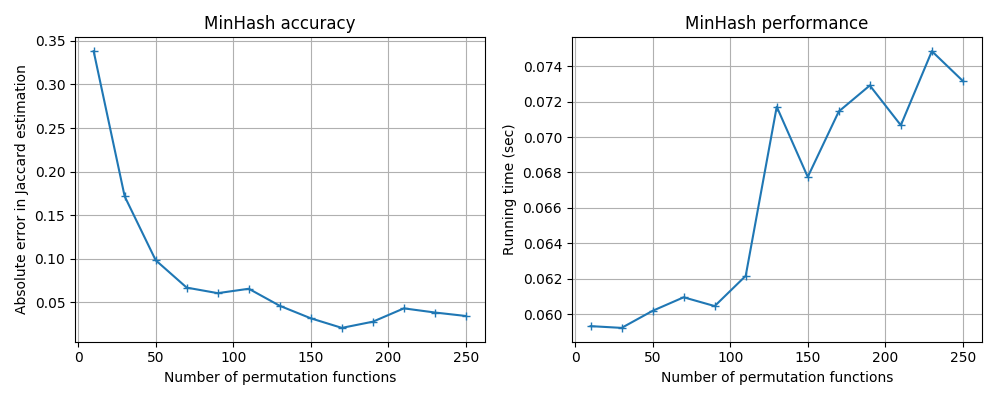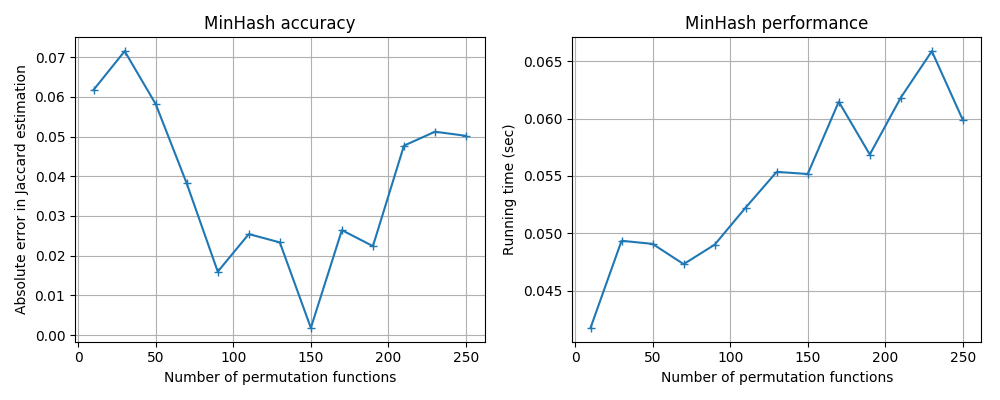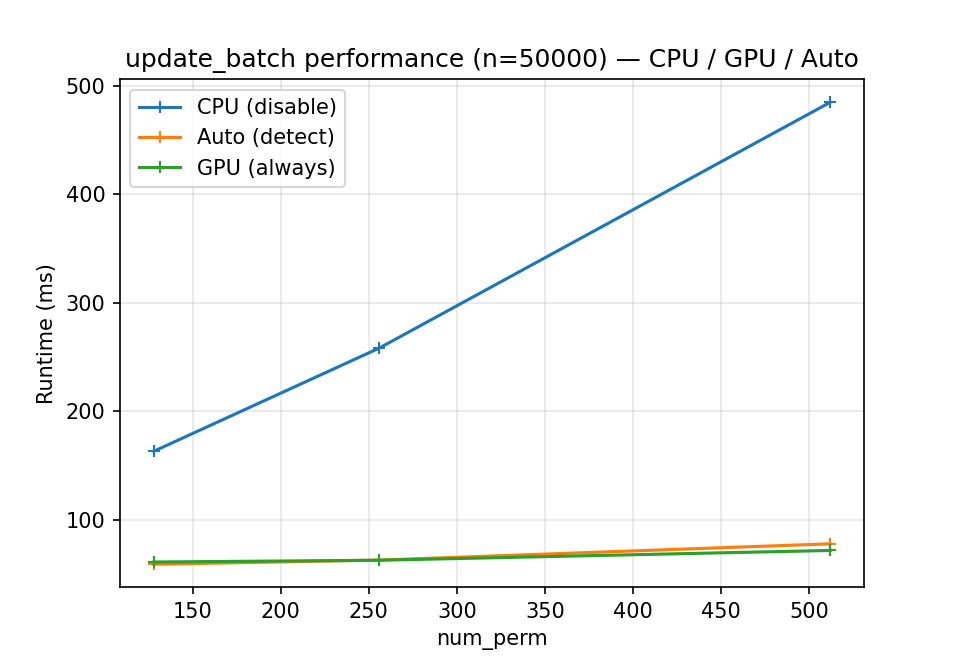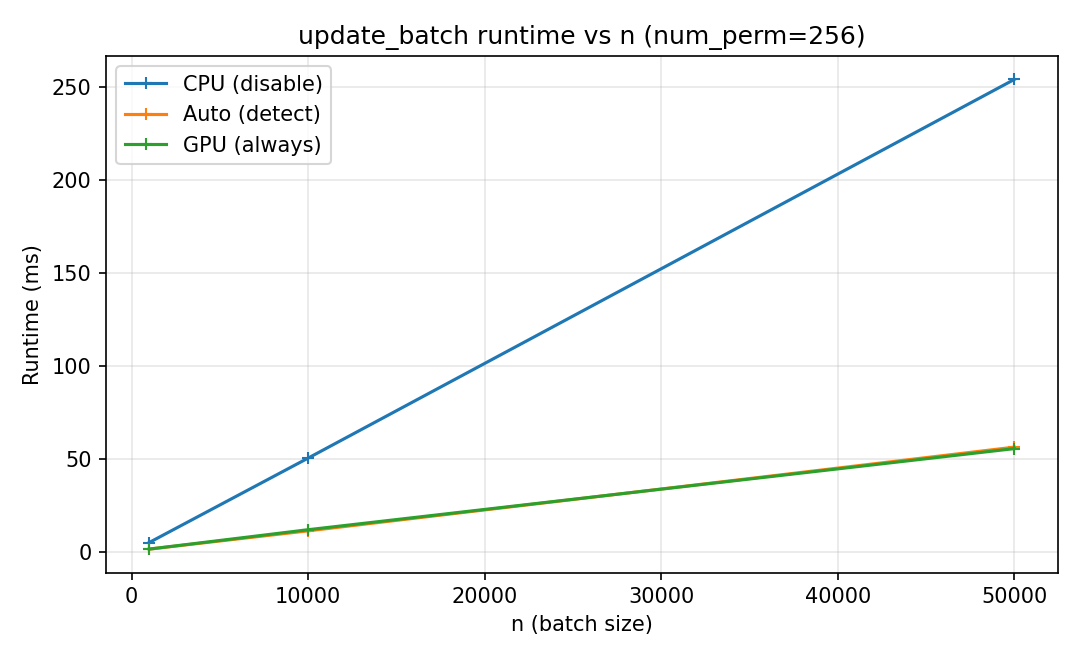MinHash
datasketch.MinHash lets you estimate the Jaccard
similarity
(resemblance) between
sets of
arbitrary sizes in linear time using a small and fixed memory space. It
can also be used to compute Jaccard similarity between data streams.
MinHash is introduced by Andrei Z. Broder in this
paper.
from datasketch import MinHash
data1 = ['minhash', 'is', 'a', 'probabilistic', 'data', 'structure', 'for',
'estimating', 'the', 'similarity', 'between', 'datasets']
data2 = ['minhash', 'is', 'a', 'probability', 'data', 'structure', 'for',
'estimating', 'the', 'similarity', 'between', 'documents']
m1, m2 = MinHash(), MinHash()
for d in data1:
m1.update(d.encode('utf8'))
for d in data2:
m2.update(d.encode('utf8'))
print("Estimated Jaccard for data1 and data2 is", m1.jaccard(m2))
s1 = set(data1)
s2 = set(data2)
actual_jaccard = float(len(s1.intersection(s2)))/float(len(s1.union(s2)))
print("Actual Jaccard for data1 and data2 is", actual_jaccard)
You can adjust the accuracy by customizing the number of permutation functions used in MinHash.
# This will give better accuracy than the default setting (128).
m = MinHash(num_perm=256)
The trade-off for better accuracy is slower speed and higher memory usage, because using more permutation functions means:
more CPU instructions for every data value hashed, and
more hash values to be stored.
The speed and memory usage of MinHash are both linearly proportional to the number of permutation functions used.

You can union two MinHash objects using the
datasketch.MinHash.merge() function. This
makes MinHash useful in parallel MapReduce-style data analysis.
# This makes m1 the union of m2 and the original m1.
m1.merge(m2)
MinHash can be used for estimating the number of distinct elements, or cardinality. The analysis is presented in Cohen 1994.
# Returns the estimation of the cardinality of
# all data values seen so far.
m.count()
If you are handling billions of MinHash objects, consider using
datasketch.LeanMinHash to reduce your memory footprint.
Use Different Hash Functions
MinHash by default uses the SHA1 hash function from Python’s built-in
hashlib library.
You can also change the hash function using the hashfunc parameter
in the constructor.
# Let's use MurmurHash3.
import mmh3
# We need to define a new hash function that outputs an integer that
# can be encoded in 32 bits.
def _hash_func(d):
return mmh3.hash32(d)
# Use this function in MinHash constructor.
m = MinHash(hashfunc=_hash_func)
Different hash functions have different performance–accuracy trade-offs;
you can use the benchmark code in benchmark/minhash_benchmark.py to
run some tests. Here are the results for some popular hash functions
available in Python.
MurmurHash3: mmh3



GPU usage (experimental)
datasketch.MinHash can optionally run part of
datasketch.MinHash.update_batch() on a CUDA GPU
via CuPy. Hashing and permutation generation remain on CPU;
only the permutation application and min-reduction may use the GPU.
Control behavior with the constructor argument gpu_mode:
'disable'(default): always CPU.'detect': use GPU if available, otherwise fallback to CPU.'always': require GPU; raisesRuntimeErrorif no CUDA device is available.
# Force CPU only
m = MinHash(num_perm=256, gpu_mode="disable")
m.update_batch(data)
# Require GPU (raises RuntimeError if no CUDA device)
m = MinHash(num_perm=256, gpu_mode="always")
m.update_batch(data)
Install. CuPy is an optional dependency (not installed by default).
See CuPy’s docs for wheels matching your CUDA version, e.g.
pip install cupy-cuda12x for CUDA 12.
GPU runtime comparisons
The optional GPU backend accelerates the permutation-and-min step in
datasketch.MinHash.update_batch(). Hashing still runs on CPU to
preserve hashfunc semantics.
Runtime vs number of permutations (fixed ``n``).

Update time for a fixed batch size (n = 50,000) as num_perm grows.
GPU shows increasing speedups as num_perm increases because more parallel
work amortizes transfer/launch overhead.
Runtime vs batch size ``n`` (fixed ``num_perm``).

Update time for a fixed number of permutations (e.g., num_perm = 256)
as batch size increases. Small batches are often CPU-favorable due to
transfer overhead; larger batches benefit from GPU parallelism.
Notes. Results vary by hardware and CuPy version. The GPU backend is
controlled by gpu_mode: "disable" (CPU), "detect" (use GPU if
available, otherwise CPU), and "always" (require GPU; raises if unavailable).